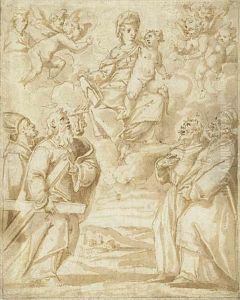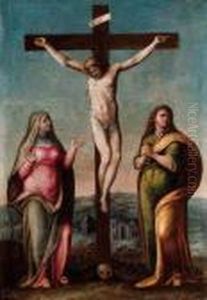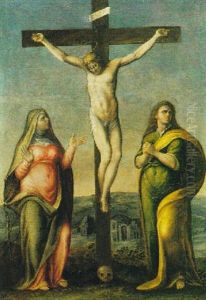Giulio Mazzoni Paintings
Giulio Mazzoni was an Italian painter and sculptor of the Renaissance period, born in Piacenza in 1525. He moved to Rome at a young age, where he became a student of Perino del Vaga, one of Raphael's most influential pupils. Under Perino's mentorship, Mazzoni honed his skills and became adept at fresco painting and stucco work, which were highly sought after in the decoration of Roman palaces and churches during the mid-16th century.
Mazzoni's work was characterized by its elegance and the delicate handling of his subjects, often illustrating scenes from mythology or the Bible. He was particularly renowned for his elaborate stucco decorations, which he used to frame his frescoes and to embellish interiors with a rich, sculptural quality. His style represents a blend of Roman Mannerism, reflecting the influence of artists such as Michelangelo and Raphael, with an attention to detail and ornamentation that was characteristic of the period.
During his career, Mazzoni received several important commissions in Rome, including work for the Vatican and various noble families. He was also active outside of Rome; for instance, he worked on the decoration of the Ducal Palace in Genoa. Mazzoni's influence extended to other artists of the time, and he played a role in the development of the ornamental Mannerist style that became prevalent in Roman art and architecture.
Despite his success, Giulio Mazzoni remains a somewhat obscure figure compared to the leading masters of his time. His works have often been overshadowed by those of his more famous contemporaries, and many have not survived or have been significantly altered over the centuries. Mazzoni continued to work well into his old age, leaving behind a legacy of richly decorated spaces that reflect the opulence and complexity of late Renaissance art. He died in 1618, leaving a body of work that continues to be studied for its contribution to the decorative arts of the Italian Renaissance.


